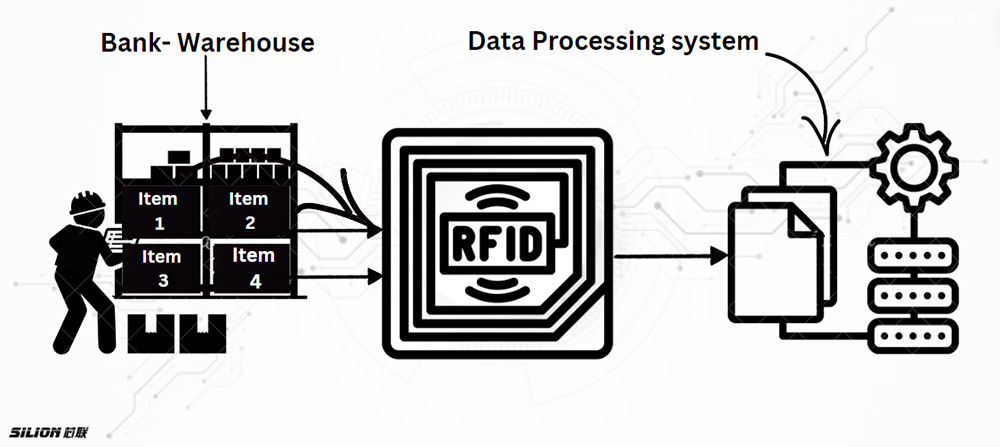Your location: Home Page > RFID Blog | SILION TECH > Transforming Bank Warehouse Management with RFID: A Path to Greater Efficiency and Security
News and Information
Transforming Bank Warehouse Management with RFID: A Path to Greater Efficiency and Security
Author:2024-09-10 15:37:11
As the financial industry evolves rapidly alongside advancements in technology, the demands for more efficient, transparent, and secure banking operations grow. One critical area that often gets overlooked is warehouse management in banks—yet it is fundamental for ensuring the security and availability of vital assets such as cash, documents, and equipment. Traditional manual methods of warehouse management are now proving insufficient to meet the growing complexities of modern banking. Enter RFID (Radio Frequency Identification) technology—a game-changing solution that is reshaping how banks manage their inventory with precision, speed, and security.

Understanding RFID Technology in Bank Warehousing
RFID technology leverages radio waves to automatically identify, track, and manage items within a given space. In the context of a bank's warehouse, this involves a network of RFID tags, readers, antennas, and a centralized data processing system that all work together to streamline operations.
Each asset in the warehouse, from physical cash boxes to sensitive documents, is tagged with an RFID chip containing essential information like a unique identifier, entry time, and storage location. RFID readers placed at key entry points or shelving units emit radio signals to activate these tags, instantly capturing their data and feeding it into a backend system. This real-time transfer of data provides a comprehensive view of the warehouse's contents, enabling swift decision-making and improved tracking of each item.
Why RFID is Essential for Modern Bank Warehousing
Traditional manual processes—where personnel are required to log entries, track assets, and physically manage stock—are inherently slow, error-prone, and inefficient. The introduction of RFID in warehouse management brings forth several key advantages:
1. Real-Time Automation and Accuracy: One of the primary benefits of RFID technology is its ability to automate data collection and update processes in real-time. Bank warehouse personnel no longer need to rely on manual documentation and checks, which are not only time-consuming but also prone to human error. With RFID, every item’s information is automatically updated in the system the moment it enters or exits the warehouse, ensuring greater accuracy and efficiency.
2. Enhanced Tracking and Inventory Visibility: RFID systems provide real-time tracking of inventory across the warehouse. Managers can instantly know the exact location of any item, whether it's a cash box, important financial document, or specialized equipment. This enables quick retrieval and reduces the risks associated with lost or misplaced assets. The system's precision ensures that time-sensitive tasks—like cash delivery or document retrieval—are executed flawlessly.
3. Improved Security Measures: In the banking world, security is paramount. RFID technology not only allows for better control of item movement but also serves as a robust security layer. Only authorized personnel with proper RFID access can move or manage items, and all entries and exits from the warehouse are meticulously logged in the system. This ensures that unauthorized access is minimized and all operations are easily traceable for auditing purposes. Additionally, security breaches can be detected in real-time, allowing swift action to be taken.
4. Cost-Efficiency Over Time: While the upfront cost of deploying an RFID-based warehouse management system can seem significant, the long-term financial benefits outweigh the initial investment. Automation drastically reduces the need for manual labor, while real-time data minimizes the potential for losses due to misplaced or stolen items. Furthermore, automated systems improve operational speed and accuracy, contributing to overall cost reduction in daily operations.
5. Scalability and Flexibility: As banks grow, their storage and warehousing needs often expand. RFID systems offer the flexibility to scale, as new items and sections of the warehouse can easily be integrated into the existing system. Whether a bank is expanding its operations to include new financial products or simply needs more space to store assets, RFID technology can adapt seamlessly, making it a future-proof investment.
UHF RFID technology represents just the beginning of a broader trend towards digital transformation in the financial sector. As RFID systems continue to advance and combine with emerging technologies like the Internet of Things (IoT) and big data analytics, we can expect even more sophisticated applications in bank warehousing.
For instance, future RFID systems may integrate predictive analytics to optimize warehouse operations further. By analysing patterns of item movement and warehouse space utilization, banks could fine-tune their inventory management strategies, ensuring that they have the right amount of stock on hand without overloading their storage capacity.
Additionally, RFID-enabled warehouses could soon be a central part of smart, fully automated bank facilities. When paired with IoT sensors and AI-driven management systems, these warehouses will become even more secure and efficient, allowing for better inventory forecasting, theft prevention, and real-time tracking of both personnel and assets.
The adoption of RFID technology in bank warehousing is more than just a technological upgrade—it is a necessary evolution in the face of modern banking challenges. By automating tasks, providing real-time visibility, enhancing security, and offering long-term cost savings, RFID systems pave the way for a smarter, safer, and more efficient banking infrastructure. As this technology matures, its role in banking will undoubtedly expand, pushing the boundaries of what’s possible in inventory and warehouse management. With RFID at the helm, banks can ensure that their assets are always in the right place, secure, and accounted for, allowing them to focus on what they do best—serving their customers.